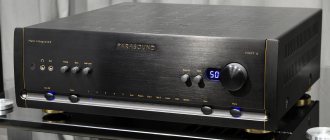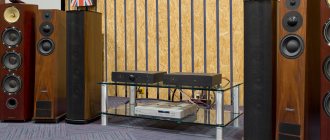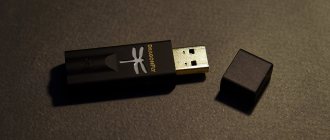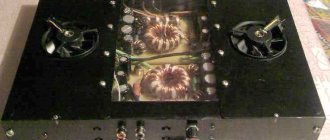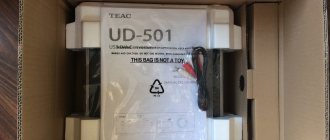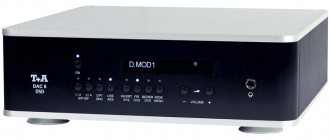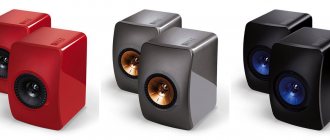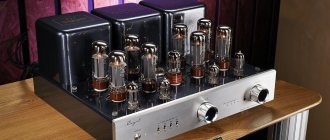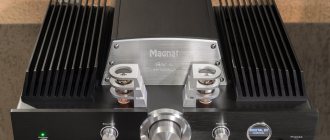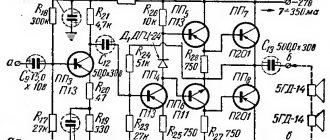The company from the Japanese prefecture of Kanagawa decided to bring together its signature traditions in creating high-quality amplifiers, modern requests for playback from digital sources and streaming services, as well as the ability to work without intermediaries with vinyl players. Let's see what came of it.
I admit, I have a special relationship with the Marantz brand. About a quarter of a century ago, a CD player with the coveted logo became my first imported component in a stack of domestic equipment - moreover, purchased for honest student part-time jobs. Since then, the signature sound has given me warm feelings - especially the pleasant musical style of the amplifiers. And therefore, I showed genuine interest in the new Marantz PM7000N device, capable of working as a classic class AB amplifier and having extensive network capabilities.
A massive shielded toroidal transformer contributes to the amplifier's hefty 10.8 kg design. Moreover, in order to reduce the overall power consumption, the developers decided to disconnect it from the power circuit in sleep mode. While the amplifier is idle, a pulse source (SMPS) is in standby mode - and as soon as the amplifier starts working, the SMPS unit turns off and transfers power to the transformer.
Like a number of other branded amplifiers, the PM7000N works with current feedback technology, which is characterized by limited impedance and, accordingly, low phase shift. Among other things, this provides the characteristic clear sound. In amplification, modules (Hyper-Dynamic Amplifier Modules - HDAM) are traditionally used on discrete elements, which, in the interpretation of the company’s craftsmen, really showed themselves to be more dynamic and more detailed than integrated op-amps. In this case, the HDAM-SA3 generation is used.
In network player mode, high-resolution recordings are processed by the AK4490 DAC, which supports files up to 24 bit/192 kHz, as well as DSD 2.8 MHz and 5.6 MHz.
Maybe you know the feeling when the desire for convenience and compactness votes for an integrated device, and theory argues that a set of separate specialized devices will do this better - also because various electronic units do not interfere with each other with interference and interference. And even widespread shielding of digital circuits does not completely solve the problem.
The shielded toroidal transformer is turned off in sleep mode, and at this time the pulse source operates
The creators of the PM7000N have also been living in the world for many years and foresaw these torments of potential users, and therefore equipped the amplifier with several ways to neutralize “extra parts”. First of all, there are three separate Pure Modes, which make it possible to disable network services, USB-A blocks, Wi-Fi and/or Bluetooth. As they say, while one is working, the others don’t interfere. This is especially true when playing analog sources - at least the same vinyl. Well, for true purists, the Marantz Source Direct function is provided, which disables the tone block.
The beginning of the way. Brooklyn Story
Today the name of the company is strongly associated with Japan, but the brand owes its birth to one person, and not a Japanese at all. Saul (or in the American style - Saul) Bernard Marantz was born on July 11, 1911 in Brooklyn (New York) in a family of Jewish emigrants from Poland.
Sol's family experienced great financial difficulties, so the young man had to quit school and get a job as a messenger in one of the many companies located in the business district of New York. Since childhood, Marantz showed an interest in technology and loved to tinker with radio devices. Nevertheless, the main passion of young Sol remained art, including music. Later, he even received an art education, attending relevant courses at the Pratt Institute in Brooklyn.
Saul Bernard Marantz
Marantz mastered the profession of a graphic artist and, having gained a high reputation, began to enter into deals with various large companies like Hanes or General Electric. It was probably this combination of technician and esthete in Saul's character that was the reason that even the early examples of audio equipment designed by Marantz were distinguished by a design that is now called "industrial" or "industrial".
One of Marantz's many hobbies was the classical guitar. Sol took lessons on this instrument and was well acquainted with the world famous Spanish guitarist Andres Segovia Torres. It was his passion for the guitar that made Marantz critical of any audio components. During World War II, Marantz served in the Navy. At the same time, he took courses in the basics of electrical and electronics engineering.
First Marantz
Saul's greatest influence was his wife Jean, who shared her passion for art and mathematics with her husband. Jean's mathematical skills served her well in the design of Marantz's first tube mono preamplifier, called the Audio Consolette.
Saul assembled this component in the basement of his house located in the Kew Gardens area (then a suburb of New York). Work on the first Marantz product began in 1948 and lasted four years. At the same time, Marantz met electronics engineer Sidney Smith, who helped him refine the device.
Audio Consolette
The Audio Consolette preamp was a universal tube component that used 12AX7 and 12AU7 dual triodes. The model had a separate external power supply and had a large set of different correction circuits used at that time for playing vinyl discs (there were 36 of them in total). The device was equipped with a loudness function, which allows you to compensate for the lack of bass at low volume levels.
In 1952, Saul showed the prototype to his friend Mike Plum, who worked as a salesman at the Harvey Radio store in Manhattan, and he helped negotiate a sale on the condition that Marantz produce 100 copies of such preamplifiers. In the wake of the popularity of the first long-playing vinyl "long plays" (LPs), the Audio Consolette preamplifier was in great demand. Later the model was slightly redesigned and improved for mass production.
Founding of the company and the stereo revolution
Marantz was founded by Sol in 1953, and Sidney Smith became the company's chief engineer. In the same year, a small factory was opened where the production of Audio Consolette began.
In 1954, the Model 1 preamplifier appeared, a slightly redesigned version of the first model, which included an RIAA equalizer for turntables that met the standards set by the Recording Industry Association of America (RIAA).
Model 2
The unit sold for about $168 (with wood trim) and soon became a bestseller. Then came the Model 2 tube push-pull mono power amplifier, designed by Sidney Smith, for which they were already asking $200. The circuitry of the model was based on the use of an EL34 lamp. In this case, the amplifier produced 40 W or 20 W when operating in triode mode.
Model 3
Marantz next developed the Model 3 two-way electronic crossover. During the same period, the external power supply used in the Model 1 and Model 3 was improved. The company soon moved to Broadway (Long Island).
Model 7
In 1958, the Model 5 tube mono amplifier was released. At the same time, a stereo adapter appeared in the Marantz lineup, which made it possible to combine two Model 1 preamplifiers to obtain stereo sound.
Model 8
At the end of 1958, the first tube stereo preamplifier, Model 7, with a unique three-stage phono preamplifier, went into mass production, which became a cult model and sold 130,000 copies, followed in 1959 by a full-fledged stereo amplifier Model 8, combining two Model mono amplifiers 5 and providing a power of 30 W per channel.
We are not afraid of difficulties
Dynaudio Evoke 50 floor-standing three-way speakers were entrusted to demonstrate the operation of the PM7000N - and the choice was not accidental. This very high-quality acoustics is demanding on amplifiers and is not entirely easy to “drive”, so it is possible to interrogate a beginner with passion. However, I was assured that the PM7000N in this setup behaves even more vigorously than the PM8006 model and reveals the capabilities of the speakers without any problems.
Actually, this is another message from the developers: the versatility of the new amplifier should be manifested not only in a wide range of sources and connection paths, but also in the ability to work with a large list of acoustics of a comparable class. Thus, in their opinion, potential buyers are freed from the pains of careful selection of components - in most cases the result will be more than good. In a word, the “post-Ishiwata” concept includes the preservation of the corporate style with an increase in power and expansion of capabilities. By the way, if you need to build a triphonic system, the PM7000N has a separate output for an active subwoofer.
The amplifier is designed to work with a wide range of acoustics
The speakers were connected to the amplifier with a thick and weighty Transparent Ultra SC speaker cable with “banana” connectors (costing more than twice as much as the test item itself) using massive brass Marantz SPKT-1+ terminals, which are generously coated with silver plating for better contact.
The Marantz SA-KI Ruby SACD/CD player from Ken Ishiwata (signed by the master) was connected to the PM7000N with a Transparent Ultra RCA cable - and again I can’t resist saying that the price of the cord this time is almost equal to the cost of the amplifier.
The TEAC TN-4D record player was also connected with the same cable. Amid the exuberant celebration of digital technology, the developers have not forgotten the adherents of good old vinyl, having equipped the PM7000N with a built-in phono preamplifier. A special feature of this block was the presence of field-effect transistors (FETs) in the input stage, which simplified the circuit by eliminating isolation transistors and improved the signal-to-noise ratio. And all this splendor was powered through a PS Audio Dectet Power Center surge protector.
60s: expanding horizons, “the best tuner in the world” and moving to California
In 1960, Marantz released the massive 70-watt Model 9 tube monoblock, which is still extremely popular. The tip featured an attractive, minimalist design. The laconic front panel with a round needle indicator in the form of a porthole eventually became the hallmark of Marantz amplifiers.
Model 9
A special modified version of this model, designated 9120, was used by the National Aeronautics and Space Administration (NASA) as an amplifier for installation in ground tracking stations as part of the Apollo program.
Model 8B
In 1961, the Model 8B stereo end was developed based on the Model 9. In the same year, another electronics designer, Richard Sequerra, joined Saul Marantz and Sidney Smith. The result of this collaboration was the Model 10 FM tuner with oscilloscope. The model was created specifically for listening to stereo programs broadcast in the FM range. In 1961, the first such FM radio service was launched in the States.
Model 10
In 1963, the SLT-12 vinyl player appeared in the model line, and in 1964, the improved Model 10B FM tuner, equipped with a tube oscilloscope that displays the power and balance of the received signal, entered the series. Despite the thoughtful design and high sound quality, the model became unprofitable and eventually virtually bankrupted the company.
SLT-12
The 10B proved to be too expensive to produce and its retail price was underestimated. Saul said: “Many people still think the 10B was the best tuner ever made. In the early '70s, we were asking $750 retail for a tuner like this, and I still compare that to me personally putting $100 in gift dollars into each shipping box."
Model 10B
In 1964, Marantz was on the verge of bankruptcy, but was bought out by Superscope Inc. led by Joseph Tushinsky and transferred to California. In 1965, the company's first transistor preamplifier, the Model 7T, appeared in the company's catalog, and a year later, the Model 15 transistor stereo power amplifier in a dual-mono configuration.
In 1967, the first transistor receiver, the Model 18, was released, equipped with an FM tuner, preamp section, power amplifier, oscilloscope and the signature Gyro Touch vernier wheel, which eventually became a classic Marantz product and the progenitor of a number of iconic models.
Model 15
Superscope was looking for a partner that could produce high quality components at a low cost. Therefore, in 1966, Marantz audio equipment began to be assembled in Japan as part of cooperation with Standard Radio Corp., which previously produced radios and tape recorders. In 1968, Saul Marantz resigned as president of the company that bears his name. Thus ended a whole milestone in the history of Marantz.
Model 18
Network or disks?
It is important for me that the amplifier reads digital streams from streaming services - in particular, the popular Tidal (I myself have only focused on it for now), Deezer, Spotify, Amazon Music and a number of others. Such services give me the opportunity to get to know the artist or album before purchasing, or simply fill the background with music in fairly good quality.
In order for Tidal to allow me access to honestly paid content, I had to introduce myself to the HEOS program as a “Turkish citizen.” Alas, the proposed interface is significantly inferior in convenience to the “native” Tidal program - you have to do a lot of step-by-step movements back and forth, awkwardly opening unnecessary menu items every second. There is a reason for the company representatives to once again kick the software developers.
But there are no complaints about the delivery of streaming content itself. I have already discovered that the sound of Tidal is highly dependent on the equipment, and a close-to-ideal option was encountered only once, when the network player alone cost one and a half times more than the current setup.
Now the PM7000N has worked well. Queen's complex 1974 composition "Fairy Feller's Master-Stroke", inspired by the painting of the same name by artist Richard Dadd (which he painted in the London mental hospital "Bedlam"), is equally crazy and, in addition, poorly recorded from the beginning. Not every piece of equipment can handle this early polyphony from Freddie. But this time, even taking a song from a network service, the amplifier sorted this bunch of sounds into a clear stage and intelligible voices with instruments. In the end, it turned out, although not the most ideal performance, but still it was possible to listen to it with pleasure, and not pain.
And if you launch performers from Tidal who are sensitive to the quality of recordings - for example, Dire Straits - then the picture will turn out completely peaceful. The composition “Money for Nothing” sounded refined, clear and smooth—nothing to complain about.
You can play your own high-records from an external server using a Wi-Fi router and the same HEOS control system. But I did it simpler - I simply inserted a USB flash drive into the connector on the back of the amplifier, and HEOS immediately saw it and offered to play content by folder, artist or album.
Well, since they said that the amplifier is capable of controlling complex speakers, then hold on - I deliberately prepared several “inconvenient” compositions, with which a number of setups had difficulties. I'll start with the vinyl digitization of the composition “Rock! Rock! (Till You Drop)” by Def Leppard, which often sounds a little washed out. But now Joe Elliott's voice finally emerged from behind the guitars, and the drum kit hammered clear and hard, as if hammering in nails. Quite decent and legible presentation. Maybe it would be nice to add a bit of the old “Ishiwato” colorfulness here, because the current interpretation turned out to be more neutral, but this is a debatable issue.
Marantz SPKT-1+ terminals are made of brass and coated with a silver layer
Muse's massive, dense "Uprising" brought out the low end without, for once, becoming a mush, and Matthew Bellamy's vocals seemed to separate and soar above them. An interesting interpretation - from my point of view, it is certainly accepted. Before listening, I was wary of the decision to use the AK4490 DAC in the amplifier, which seemed to me too bright and harsh in a number of devices. But the well-known saying “it’s not the DAC that’s important, it’s the harness” is true, and the developers managed to make the chip from Asahi Kasei sound in unison with its signature smooth melody.
Now it's time to listen to the heavy mix of guitars, drums and pulsating electronics in Rammstein's "Radio". The amplifier paired with speakers cleared the composition from the rumble, separated the instruments and clearly identified the vocals. The acoustics control did not cause any complaints, and the low frequencies, which noticeably vibrated the massive chair under me, became completely curbed and tamed.
And now I confess something. From the Yello group I respect, I very rarely include in tests the song “Oh Yeah”, which at the bottom often breaks into wheezing, or even completely indecent sounds - why upset the owners of the equipment. This time the amplifier and acoustics worked on the edge: nothing wheezed from below, and in the rest of the range it sounded more than decent. I won’t say that I experienced audiophile delight, but you can listen – and even enjoy it.
During the test, the remote control was used infrequently - the main control was carried out from a smartphone using the HEOS interface
You know, there are times when you finally manage to fully hear some composition for the first time - and this does not always depend on the price and class of equipment, but more on the “resonance” with your own perception. The song “Toska” by the St. Petersburg group “Stolen Sun” re-showed detailed instruments, rounded articulate sounds of the bass guitar and above them the aching voice of Jeff (Evgeniy Anisimov). And this is by far the best interpretation, coinciding with my vision of how it should sound.
Now let’s listen to how high-res is perceived when processing a proprietary CD player from SACD discs. JSBach's "Toccata & Fuge" performed by Cameron Carpenter showed the setup's ability to sound clearly over a wide dynamic range. The powerful voice of the organ passes through you like an x-ray, and you can feel its smallest nuances and overtones.
The jazz compositions “Take four” and “Caravan” from the disc “Alexey Kurochkin “Among Friends” (Butman Music) demonstrated an unusually lively, detailed and natural presentation of instruments, and at the same time the fact that the PM7000N device is, first of all, a good amplifier, and all its digital player functions, although they look very decent, are still secondary and inferior to the real master in the person of Marantz SA-KI Ruby from a different price and music category.
The TEAC TN-4D vinyl player with a Sumiko Oyster MM cartridge, using the phono stage built into the PM7000N, also could not outperform the CD player - also different weight (price) categories. Although the sound, in general, did not cause any complaints. The disc by violinist David Garrett (aka German David Christian Bongartz), known for his ability to turn any classical piece into sweet pop, played cheerfully and cleanly. But I think the amplifier has enough potential to properly make a higher-end player with an external phono stage sound.
70s: a new story
Thanks to an infusion of new blood from Superscope and Standard Radio Corp., Marantz began to grow rapidly, releasing more and more new products, including a growing list of preamps and integrated amplifiers, speakers, stereo receivers (the iconic 2200 series and others), tuners, turntables and speakers. .
Stable financial support and new production facilities built in Japan ensured further expansion of the Marantz company. So it was a decade of intense growth.
In 1974, a note appeared in the press about how a fire broke out in the house of Francisco Espina, who owned a Marantz 2270 receiver. When Francisco found the device among the pile of charred rubble of his mansion, installed a new power cord and turned it on, he was very surprised - the receiver still continued to work, sent a signal to the speakers, headphones and pleased the eye with a pleasant blue indication.
2270
Francisco's memories: “Out of curiosity, I brought the damaged receiver into my apartment and, connecting a new power cord, plugged it into the outlet. The blue light turned on. I connected headphones and FM radio, and everything worked great. Then I tested it in conjunction with a tape recorder, and then with a turntable and speakers. The sound remained just as flawless.”
2600
In 1975, Standard Radio Corp. changed its name to Marantz Japan Inc. In 1978, the company expanded its line of receivers with the Model 2600, which became one of the most powerful devices in its class at the time, delivering 300 watts per channel at 8 ohms and 400 watts at 4 ohms.
Book of Changes, Ken Ishiwata, the beginning of the digital age and the first Marantz CD player
The next decade made its own adjustments to the history of the brand. In 1980, Superscope sold the 50% stake it held in Marantz Japan, as well as the rights to the Marantz trademarks and worldwide marketing (excluding the US and Canada), to Dutch giant Philips Electronics.
Ken Ishiwata
In 1978, a man came to Marantz Europe who played one of the key roles in the further history of the company. This person was Ken Ishiwata, who previously worked as a technical coordination coordinator at Pioneer Europe. For two years he served as manager of modernization and product improvement, i.e. headed the design and engineering department.
Ishiwata was both an experienced designer and engineer, with a passion for electronics and music since childhood. “When I was ten years old and the first LP-format vinyl albums had just begun to appear, I was already mastering my first amplifier. One day, my friend’s father, who was a real audiophile and had a very well equipped private listening room, invited me to listen to a Julie London recording,” Ken recalls.
Model 7C
The young man knew this album very well (“Julie Is Her Name” from 1955), but he was struck by the presence and high sound quality, one of the “culprits” of which was the Model 7C preamplifier. It was this recording that Ishiwata later often used to demonstrate Marantz audio equipment.
CD-63
In 1982, Marantz released its first CD player, the CD-63. In fact, it was a copy of the legendary Philips CD100 CD player, which was only slightly different from it cosmetically.
Words from Ken Ishiwata: “At the time, Philips and Marantz were the only companies using a technology called 4x Oversampling Technology, and I soon discovered that this went a long way toward creating an excellent soundstage.” which such CD players possessed."
CD73
Then the legendary CD player with a retractable drive unit CD73 appeared (an analogue of another legend - the Philips CD303 on a TDA1540 chip). Later, a very unusual “double-decker” model CD-12 was released, consisting of a pair of blocks - a CD transport with a Philips CDM-1 drive made of aluminum alloy, and a DA12 DAC, which was based on the TDA1541 S1 chip, well known among audiophiles.
CD-12
Ken Ishiwata o. The Marantz brand also released the first LD video player, CDV-780, using LaserDisc as optical media.
CDV-780
According to some rumors, it was during this period that Sol Marantz himself contacted Ken and uttered his catchphrase: “I’ve done everything I could with monophonic and stereophonic vinyl LP discs, now it’s your turn to do something with a CD.”
Ishiwata also pioneered the term SE (Special Edition), which indicated a specially modified and improved product. It all started with the fact that a number of unsold copies of the CD-45 model, which used 14-bit Philips TDA1540 DACs, had accumulated in the company's warehouse, while competitors had already switched to 16 bits.
CD-45
Ken himself modified this model (optimized the wiring and replaced some elements), gave it the name CD45 LE (Limited Edition) and began sending it to retailers and reviewers under the slogan “the most musical CD player in the world.”
TT1000
During the first two weeks, about 2,000 copies of CD45 LE were sold, and this practice was used more than once and developed by Ishiwata in the future. Nowadays, Marantz products with Ken's design changes and customizations have the KI Signature prefix in their name (the abbreviation KI was first used in 1993 after Ken improved the CD63 Mk II player) and are sold with an exclusive logo and a certificate signed by him personally.
NA-11S1
Thanks to this practice, Ishiwata gained fame throughout the audio world and subsequently became an honorary brand ambassador. Looking ahead, with Ken's arrival the company released many products that eventually became Hi-Fi classics, from the TT1000 turntable to the NA-11S1 network player.
Control cabin
The Marantz PM7000N is the company's first network-enhanced amplifier to feature HEOS technology from Denon (a sister brand to D&M Holdings). Through it, wireless control of the amplifier and devices connected to it is carried out. First of all, this makes it possible to get rid of a scattering of remote controls and makes the process more convenient and clearer.
Downloading the HEOS control program from the mobile application store, registering in it and connecting to the local Wi-Fi network (the device operates in the 2.4 GHz/5 GHz bands) was a matter of just a few minutes, and now I see the Marantz PM7000N amplifier itself in the menu, as well as the entire list of possible actions and settings. HEOS itself loads “stamp” images for the albums being played. Also, track information is duplicated on the amplifier’s large and easy-to-read display.
I found the virtual Pure Direct switch in the HEOS settings menu and tried out the feature with different sources, starting with a USB flash drive. Frankly, the effect turned out to be rather esoteric - that is, it seemed to me that when this mode was turned on, the sound became a little clearer and more detailed. But whether this really happened or whether self-hypnosis worked, I cannot say.
Another observation: when Pure Direct was turned on, there was no noticeable difference between playback from the USB input, CD player and vinyl player (Phono input). It can be assumed that the hypothetical interference was below the capabilities of the acoustics or my hearing threshold (or even both).
The day before the test, I had a cold and hoarseness, and therefore began to worry whether I could control the amplifier using the voice services of Google Assistant, Apple Siri, and even Amazon Alexa. But forgive me, such a desire did not even arise. I really shouldn’t yell over loud music, demanding to change the volume, pause the track, or play the next song, when this can be done with a light touch of my finger. Just know that if you happen to be kneading dough or winding yarn, you can operate the device without your hands.
A variety of digital and analog inputs turns the device into a single center for processing and amplifying the signal of your stereo system
I also did not test connections via AirPlay 2 and Bluetooth. All compatible devices connect wonderfully, but listening to low-resolution files with such a serious setup is like hunting woodcock with a Shilka anti-aircraft gun. However, if, beyond expectation, such a need arises, then the PM7000N will provide it to you in the best possible way.
Audio/video 90's
The company entered the 1990s in its best form, fueled by restored corporate unity. American and Canadian facilities, dealer networks, as well as the main assets of Marantz, owned by the Philips giant, were united under one flag.
SM-80
Soon the assault on the AV market began. The first armor-piercing weapon in this direction was the THX-certified Marantz SM-80 amplifier.
In 1996, the critically acclaimed SR96 AV receiver was released and also received THX certification. The company also introduced its first LCD projector, the VP8770, and a plasma monitor, the PD4280.
MusicLink
In the 90s, mini Hi-Fi components from the MusicLink series appeared, the unique SC-5 preamplifier with a separate battery power supply, the SM-5 power amplifier, the massive Project T1 tube end, etc.
SC-5 and BB-5
In 1996, the company also released replicas of its classic audio components, including the Model 7T preamplifier, Model 9 monoblock and Model 8 stereo power amplifier. In 1997, the company's founding father, Saul Marantz, passed away at the age of 85.
Project T1
It should be noted that during this period, Ken Ishiwata actively opposed management's plans to completely repurpose Marantz for home theaters. The Hi-Fi department was able to defend itself, which subsequently bore fruit. And at the same time, not all Marantz projects under the corporate umbrella of Philips were successful.
According to Ishiwata, the rejection of Japanese driver supplier Tonegen (Fostex) for the new LD-50 speaker system led to disappointing results. As a result, the production of Marantz speakers was effectively curtailed.
Also, the history of the relationship between Ken Ishiwata and the Japanese management of Marantz remains unclear. It is known that from a certain point Ishiwata stopped traveling to his homeland, and in Japan itself, models with the abbreviation KI never went on sale at all.
The luxury of Marantz amplifiers
The Marantz company has produced and is now producing in a consortium with Denon and others (D+M Holdings) many excellent amplifiers, but there are those that are beyond the household level - and I want to talk about them.
Let's take the Japanese versions as a basis due to better documentation on the Internet. As for the basic Hi-Fi series, everything is banal - in my understanding, real Hi-Fi from Marantz starts with the 6000 series amplifiers - 6001-6002-6003-6004-6005-6006.
This is still one of the most successful budget ($850 - wow budget) integrated amplifiers. Versions 6005 and 6006 are distinguished by the presence of a built-in DAC. If previously the CS4398 chip was in charge of completely converting digital into analogue, now its place is beginning to be taken in some new Asahi Kasei models, although the chip is already quite old AK4490, but CS4398 was even older.
Marantz's household line extends from the PM-6006 to 8006 model. Formally, the line starts with the PM-5005 model, but I would not recommend falling “so low”, because the word Hi-Fi can no longer be applied to the 5005, it starts in my in terms of sound, at least from 6006 (6001-6006, respectively).
If you are hooked by the sound of the 6000 series, then I don’t think it’s advisable to waste time on going from 7005 to 8006, since apart from an increase in power and minor improvements, you still won’t get anything, the sound will remain moderately rough, that’s all that can be given in sound, it already gives 6006 in this category, but what’s more is more like catching fleas than a leap forward.
And a leap forward occurs when moving to another stage of evolution. Marantz calls this the reference series and consists, for example, of the PM-KI Ruby, PM-10 (class D), 14S1 models.
Therefore, my advice after the 6000th series is to immediately switch to the reference one. Of course, the reference series is very expensive, so further we will talk about used models of the reference series, which are quite affordable and sometimes cheaper than the cost of new models from the household, or Hi-Fi, series in the Marantz classification.
Let's start with the most ambitious amplifier - the flagship 1994 Marantz PM-15.
The cost of the model was 450,000 yen, in a simplified way you can imagine 94 and 4,500 dollars, for the discerning - welcome to the CPI calculator section of the site, which will tell you that this is the equivalent of today's 7,000 dollars.
This is a luxurious device with balanced inputs, weighing 32 kg. Let me just say that the height of the amplifier is 21 centimeters with a standard full-size format of 454 x 467!
It’s extremely rare for a device to go on sale, and it’s something that can make you tremble at the mere mention of it.
So that you are not mistaken, much later, a simpler model appeared with the number 15 in the name, supplemented by letters, it is in no way comparable to the flagship 15, because it was part of the line in which there were models 19-17-15-13-11, where 11 was the flagship .
For those who could not handle the 15th model, the company offered its simplified version - Marantz PM-14, which was released 4 years later, in 1998, at a price of 200,000 yen.
There were also balanced connectors here, which is the equivalent of the top-level concept in Marantz's reference line. The device has lost weight to 23 kg, and its front panel height has decreased to 16.6 cm.
Otherwise, it was certainly still the same ultra-luxurious device.
This model, of course, became extremely desirable for lovers of high-end sound, and variations of it were produced over the years.
1999 - 14SA at the same price of 200,000 yen, XLR.
2002 - 14SA ver 2 priced at 230,000 yen, XLR.
But at the time when the Marantz pm-15 was released, so that there was no comparable device next to it, but was still able to provide a serious level of audio for demanding audiophiles, the company in 1995, following the 15, released the Marantz PM- model the next year. 16.
This model is in a much more acceptable price range - 160,000 yen, versus 450,000 for 15.
But it also underwent very serious simplifications. First of all, the amplifier lost its balanced inputs, which has already reduced the class of the device.
By the way, if you are erudite on this topic, you might have noticed that in the context of model 15, I do not mention the earlier amplifiers 95-99, which were also of an extremely high class. But the price range certainly puts everything in its place; none of the previous devices could reach such heights as the PM-15.
Let's look at the chronology
1988 - Marantz PM-95 - 319,000 yen, built-in DAC with 2x TDA1541A-S1
1991 - Marantz PM-90 - 160,000 yen - the basis of the top models, 27 kg (due to the “marble” sidewalls).
1992 - Marantz PM-99SE - 330,000 yen, XLR - based on the 90.
And then in 1994 the integral king came out - Marantz pm-15 at a price of 450,000 yen. And it is not based on previous integral models. Its filling is some kind of its own solution, perhaps developments from the world of pure power amplifiers. Why can we draw this conclusion?
For example, for the reason that the simplified model of this amplifier PM-14SA ver 2, released later, in 2002, borrowed the filling from the MA-9S1 power amplifier costing 650,000 yen (for 1 monoblock), released in the same 2002, as well as from SC -7S1 and earlier PM-14SA.
Which confirms my words. unless it could turn out that it was the developments for the flagship integrated PM-15 that served as the prototype for everything else - I couldn’t find information on this point.
So, before model 14, Marantz had a simpler luxury model PM-16, but devoid of XLR, although it also incorporated developments from the SC-5/SM-5 power amplifier. The SM-5 came out in 1994 at a price of 520,000 yen (for 1 monoblock) + it required an SC-5 preamplifier costing 680,000 yen. Let's add the amount. And in the article about the creation of a preamplifier for the SC-5, it is mentioned that to create it, developments were taken from the PM-15 integrated circuit model. Feel the level!
Well, okay, these are all hellishly cool models, and I hope you understand that the only thing cooler than the integrated PM-15 can be the 2 times more expensive power units + pres from Marantz - it’s logical. But even now the price tag will make your legs tremble.
Therefore, let’s go down a little to our land, because in this reference line there are, albeit greatly simplified, but nevertheless luxurious models.
We're talking about Marantz's later creations - the 17 and 15. The 13 and 11 are quite new and expensive, I'm not mentioning them, except for the fact that the 13 still doesn't have XLR, only the 11 can boast of that.
So in 1997, a more affordable model, the Marantz pm-17, was released, costing only 100,000 yen and weighing 15 kg. What could be left in it from higher technologies? But you know, it could have remained. Luxurious microdynamics, charisma, transparency.
There were several sequels - 17SA for 110,000 yen in 1999, and 17SA
ver 2 in 2002 for 120,000 yen, as well as variation 17 as a separate power amplifier.
There was also an even worse model - Marantz pm-19 - 68,000 yen (1998), but we can’t talk about it seriously anymore, here we will slide down to the everyday level. Although if you were planning to take 8006, then...
The luxurious Marantz PM-15S1 and S2 models also remain relatively affordable. Unfortunately, they also no longer have balanced inputs, they are not classy, but they sound extremely good - very transparent, microdynamic, but for my taste there is still a certain preponderance of balance in the bright side, like, for example, the Nec A-700.
At this point, I declare this trembling over audio treasures closed.
